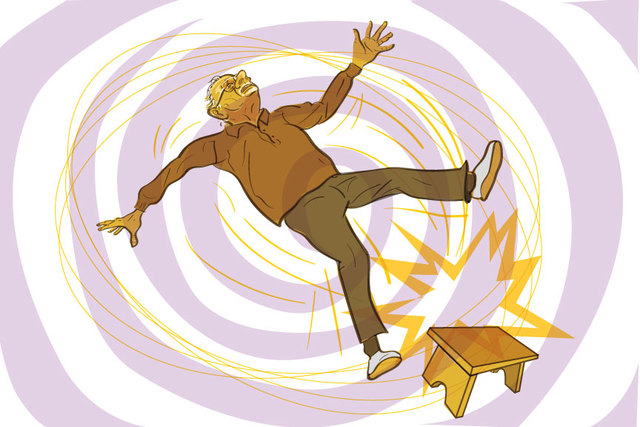Seniors can avoid slipping into danger

If someone had told Thomas Spencer he would end up in the hospital because of picking up a can of soda in his living room, he would have said that was crazy. But that’s essentially what happened about a week before Thanksgiving.
Spencer, a 66-year-old retired teacher, was carrying the soda from the living room into the kitchen when his cane got caught on a chair, his foot got hung up on the cane and he fell. In seconds, he had a shoulder broken in three places and a broken right hip.
“I ended up with a real appreciation, even though I’m 66, of elderly people who end up in skilled-care centers because of falls. I mean, their life changes immediately, just in an instant, and it gives you no chance to prepare for anything,” Spencer said.
Every year, about one-third of Americans age 65 and older fall, often sustaining injuries that can temporarily limit their independence or significantly affect their mobility, health or lifespan. As the youngest of the baby boomers edge into their 50s, the rate of senior falls is only expected to keep rising.
The Centers for Disease Control and Prevention reports there were 2.4 million falls among older U.S. adults in 2012 that were treated in emergency departments and more than 722,000 of those patients were hospitalized. Also, falls are the leading cause of fatal and nonfatal injuries among seniors.
The overall medical cost of falls in the U.S. was about $30 billion in 2012, but the aging population means the total is expected to double by 2020.
Beyond the numbers is the way someone’s life can change so quickly.
In early December, while still recovering at Valley Hospital and Medical Center from the surgeries that pieced him back together, Spencer talked about having to enter a rehabilitation center once he was discharged, and his worries about the cost of all the medical care.
Still lingering was the shock of losing his independence. His two sons have had to help him get his life back on track. One of his sons temporarily left his home in the Midwest to help.
“It’s just a domino effect, it’s traumatic,” Spencer said.
Older adults may not fear getting injured in falls, especially if they’re just barely into their senior years. Others have a more fatalistic attitude, reasoning falls will either happen or they won’t.
Local health care providers say the risk of falling doesn’t have to feel like a giant question mark looming on the horizon. There are ways to assess someone’s risk and address it.
David Morgan, director of rehabilitation at Spring Valley Hospital and chairman of the hospital’s fall prevention committee, said that about 60 percent of senior falls occur in the home. Among the more serious injuries he sees are hip fractures, fractures of the spine and head injuries.
Many times seniors will not tell their family about a fall because they’re embarrassed or fear they could lose their independence or be forced to live in a long-term care facility, he said.
“So they don’t tell people as often as they should when it could be something as simple as changing their medications, going through a round of therapy to work on strengthening the weakened muscles that are making them more prone to a fall, or just having somebody come in and assess their home to reduce obstacles and barriers that are keeping them more at risk,” he said.
Dr. Lisa Rosenberg, a geriatrician and faculty member at Touro University Nevada, said she regularly discusses the issue of falls with her patients. One of the most common risk factors she looks at is the side effects of medications, especially for patients on multiple prescriptions.
Anti-anxiety drugs such as Ativan and Xanax, for example, can impair someone’s ability to respond if they are off balance and start to fall. Prescriptions to treat depression, lower blood pressure or slow the heart rate also can create potential risks, she said. Often, reducing these risks is just a matter of readjusting dosages or prescriptions.
Diabetics, she added, need to keep their blood sugar in check so they avoid issues such as blurred vision and weakness.
Other risk factors are arthritis, pain in muscles and joints, poor vision, cardiovascular issues and even sleep apnea because “the brain didn’t get enough oxygen during the night so those people are prone to cognitive impairment,” she said.
She said misuse of medical equipment such as canes and walkers also poses danger. It’s also important to be fitted with the equipment by professionals such as physical therapists to ensure that it provides the right balance and weight-bearing support. A cane that’s a family heirloom, she added, may be beautiful to look at, but it could also be dangerous.
Another important factor to consider is fear of the unknown, observers said. Often, people who have already fallen at least once, will purposely avoid activity and even isolate themselves at home. This is one of the worst things they can do.
Anna Hutchison, a Valley Hospital physical therapist specializing in exercise for aging adults, calls this “tunnel vision,” — the idea that staying close to home and moving as little as possible will keep them safe. The drawbacks, though, are that endurance diminishes, bones and muscles weaken, and tolerance for sitting upright can decrease, she said.
After a serious fall that requires hospitalization, therapists will work to improve patients’ balance and reaction time and strengthen bones and muscles through weight-bearing exercises. Therapists will also help patients work with equipment such as canes and walkers so they regain their independence, she said.
Weight-bearing exercises such as walking can help keep bones strong, for example. And tai chi is being touted as one of the best ways for older adults to increase flexibility and strength, observers say.
They added that any exercise program for older adults at risk for falling, including a past fall, should first be discussed with a physician.
Patients can benefit from being their own health care advocates. Studies show, for example, that being screened for falls risk and addressing those risks with a prevention plan can make a significant difference.
Seniors can get screened by their physician but there are also community programs. Locally, Touro University offers assessments through its Falls Management and Mobility Clinic every second and fourth Wednesday of the month. The appointment-only clinics take place through its Active Aging Center.
The Nevada Falls Free Coalition, a partnership among entities such as Touro and the Southern Nevada Health District, provides screenings around the valley every September during national Falls Prevention Awareness Week, said Mike Bernstein, the health district’s injury prevention program coordinator.
The coalition also trains facilitators for Stepping On, a series of classes for at-risk seniors that addresses medications, moving safely, bone health, in-home-fall hazards and exercise.
Since the coalition was created a few years ago, classes have been offered in communities such as Sun City Summerlin, and at senior facilities such as the Centennial Hills Active Adult Center.
Nevada HAND, a nonprofit corporation providing affordable housing for valley residents, including about 2,800 seniors ages 55 and older, will launch Stepping On classes early this year as part of its emphasis on resident safety and wellness.
Facilitators see the program as a way to educate residents and family members about risk prevention, and let the seniors know they needn’t face their concerns about falls alone, resident services coordinator Laura O’Gara said.
“Once people do start to fall it kind of starts a downward spiral,” she said. “And we want to prevent that from happening in the first place, but also just getting them some basic knowledge about how to prevent falls, to get them exercises they can do, and to feel more confident about doing things, not isolating themselves.”
THINGS TO CONSIDER
Here are a few additional issues to consider for reducing fall risk:
— Making the home hazard-free is vital as one ages. It can include adding grab bars to the shower or near the toilet, ensuring throw rugs are nonslip and moving furniture so it doesn’t block pathways. It’s also important to have good lighting in a home, especially at the top and bottom of stairways, said David Morgan, director of rehabilitation at Spring Valley Hospital and chair of the hospital’s fall prevention committee. Both Mayo Clinic and the Centers for Disease Control offer online fall-prevention tips. Also, Medicare will sometimes pay for a home assessment.
— Geriatrician Dr. Lisa Rosenberg asks her patients who normally use bifocals or trifocals to consider, instead, having different sets of eyeglasses so an entire lens is appropriate for a particular activity such as reading or walking. “If you are looking where you step and you look through the wrong lens (on a bifocal or trifocal prescription) and it’s not focused, you can miss a step and fall down,” she said.
— Women should be aware that issues such as low estrogen or vitamin D as they age can weaken bones and increase risk for fractures, said Anna Hutchison, a physical therapist at Valley Hospital. Long-term use of steroid medications, smoking and drinking can also affect bone strength and density for both men and women.


















